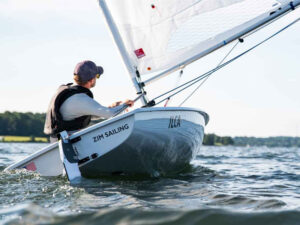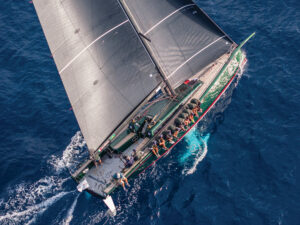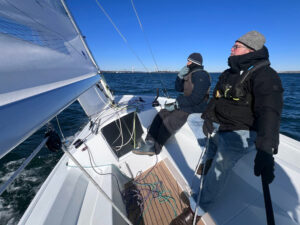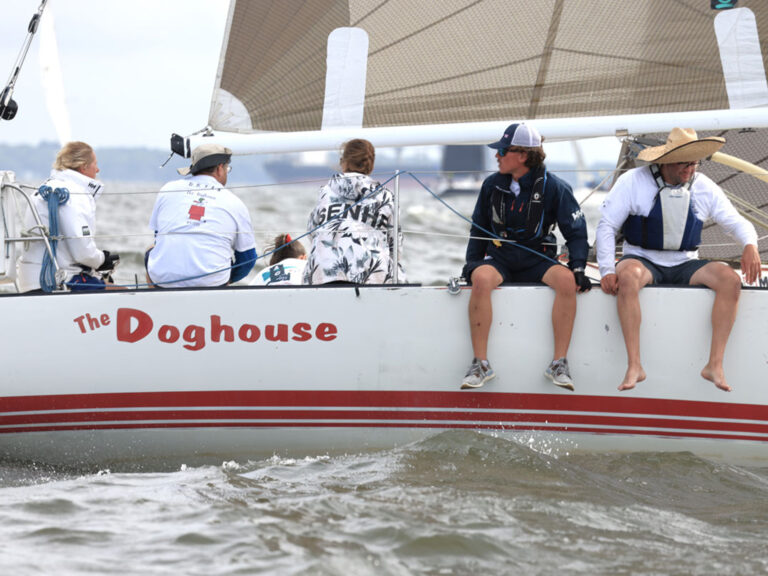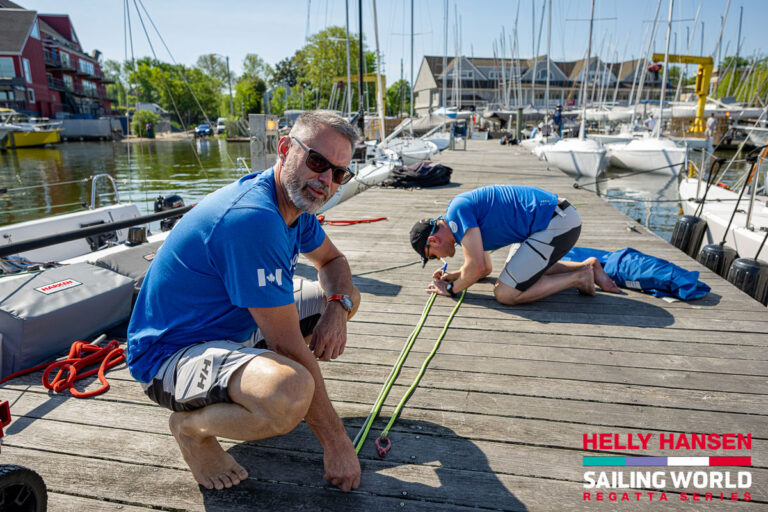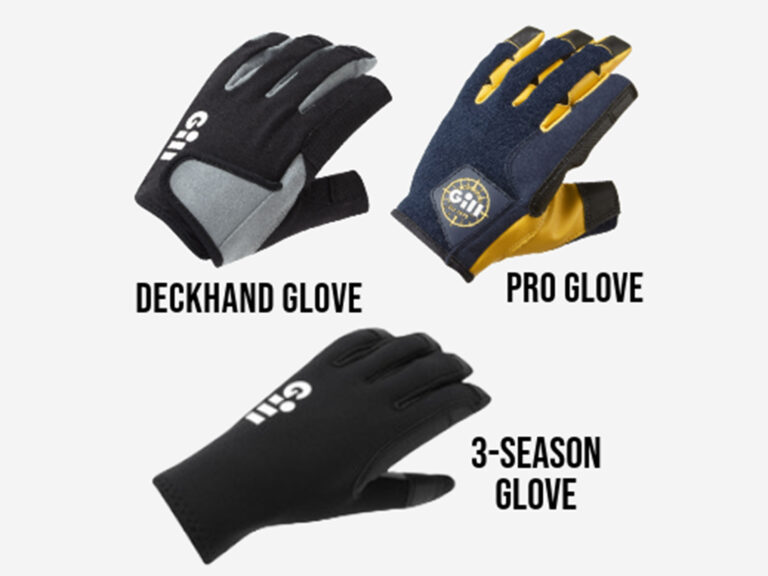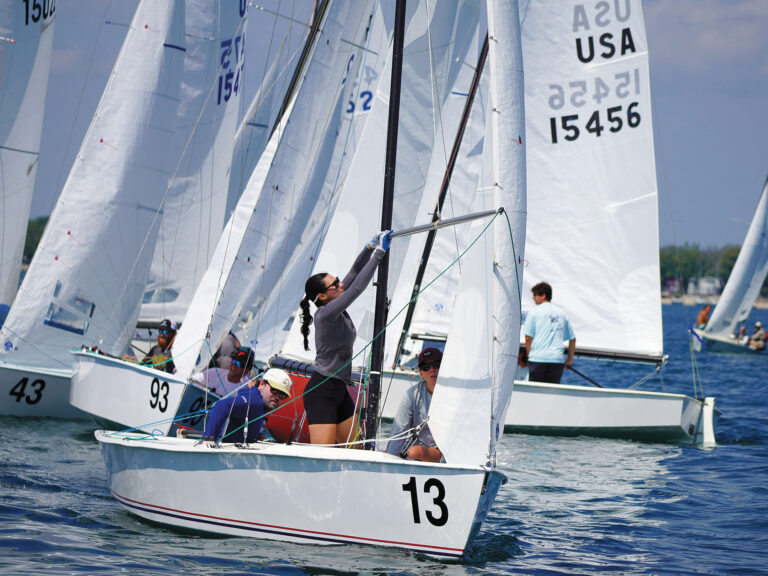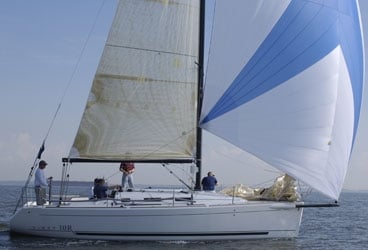
Ben10Rst
For the second half of 2006, the Beneteau First 10R flew under the radar, competing in IRC and PHRF events on the East Coast. But as the new boat on the block, it was having a hard time getting results and respect. That all changed, however, when Robert Oberg’s Annapolis-based 10R NKE Electronics dominated its 13-boat PHRF 3 class at Acura Key West Race Week, and won the inaugural PHRF National Championship. The Beneteau First 10R resembles its ancestors, such as the popular First 40.7 and First 36.7, but one obvious attribute is a departure for the 123-year-old company. The bowsprit, mounted on the starboard side of the bow, which makes the 10R the first sprit boat Beneteau has offered to its North American market. The 10R is also the first model built using the company’s proprietary “One Shot” infusion process, in which the hull and structure are molded at the same time, achieving an even distribution of the resin throughout the entire boat. The hull and deck are balsa cored, except below the waterline, and under deck fittings, where solid glass is used, which makes for a light hull for a boat the 10R’s size, around 9,800 pounds.Farr Yacht Design, a partner with Beneteau for many years, designed a smart interior for the 10R. By placing the head on centerline in the forepeak, they’ve created one of the best spinnaker-retrieval and launching spaces found on any production boat today. The large, half-moon hatch provides good ventilation dockside, and a more than adequate opening for spinnaker work. The head’s sole is covered with molded nonskid and has a drain in the center to drain away water from wet spinnakers. The carbon spinnaker pole retracts into a fiberglass sheath in the head two rubber gaskets prevent water intrusion. Any water that does manage to sneak in drains via a weep hole and clear rubber tube led to the bilge. Aft of the head/spinnaker operations center is a bulkhead that’s tabbed into the hull, as is the bulkhead aft of both settees, which supports the load from the shrouds and keel. Aft of the bulkhead on port and starboard are two straight settees (curved settees are great for dinner parties, but make lousy offshore berths), which flank a drop-leaf table. The portside, L-shaped galley is across from the nav station, and since both are at max beam, they’re both roomy. In fact, the nav station, which faces forward, is roomier than some larger boats we’ve sailed. Aft to starboard is the owner’s stateroom with a double bunk, to port a single. Thanks to the head-forward layout, both aft berths are further forward than they might otherwise be, which keeps weight out of the stern.Racers who’ve spent time racing aboard the First 36.7 have found true happiness with the First 10R’s cockpit, which has plenty of room for helmsman, main trimmer, two headsail trimmers, and a pitman. Immediately forward of the open transom is a large hatch, which accesses a storage area that accepts an optional liner designed to hold a small liferaft. The large, 63-inch aluminum wheel is covered with leather, and with only three-quarters of a turn lock-to-lock, is designed to provide the same precise, fingertip control as a tiller. The Harken mainsheet traveler is immediately forward of the wheel, and thanks to the low cockpit coamings, is an extremely comfortable area for the mainsheet trimmer, especially when the boat is heeled. Fine and gross-trim backstay controls are well within the trimmer’s reach on either tack. Two Lewmar 46 AST winches are mounted on the cockpit coaming for headsail trim, and two Lewmar 40s sit on either side of the companionway to handle the halyards and control lines leading aft from the Hall carbon-fiber mast. Twin banks of Spinlock jammers sit forward of the two Lewmar 40s. Because the cabin trunk extends very far the genoa and jib tracks are pushed outboard of where they really should be, the 10R requires jib inhaulers for the 150-percent genoa, and the jib, allowing the clew to be sheeted inboard around the shrouds. Thanks to the fact that the headsail’s Harken furler sits belowdecks, 10R owners get the best of both worlds, a proper deck-sweeping headsail, and the ease of a furler, which makes mark roundings a lot less complicated.The 10R’s deck has molded non-skid, which, during our test sail last fall, we found provided good traction. The boat we sailed was an early production model, with an uncomfortably high toerail that make it painful to hike, but we’ve been told that more recent builds have lower toerails. The only feature on the 10R that gave us pause before we even sailed the boat is the high aspect, T-shaped keel. In our opinion, the T-keel is problematic when it comes to snagging lobster and crab traps, kelp, and assorted oceanic garbage. While the management and design team in France insist that it’s “not a problem,” U.S. dealers have told us that there’s a kelp-cutter design in the works. It would be a good addition for those who race in areas where this can be a problem to become skilled at performing backdowns under sail, as well as carrying a weed stick.We test-sailed the First 10R in a breeze that stayed between 6 and 10 knots for the duration of our sail. With the 150-percent overlapping genoa, the 10R powered up quickly as the wind hit its top end for the day. Upwind, we recorded between 5.8 to 6.5 knots on the handheld Garmin Gecko GPS. Sailing downwind with the asymmetric, we reached a high of 7 knots. Crewing the 10R was a delight. From the footrests for the helmsman, to the eminently workable cockpit, and ergonomic deck layout, Farr and Beneteau’s vast experience designing and building racer/cruisers is evident in every aspect of the 10R’s performance. Few sailors in the U.S. have as much time behind the wheel of a 10R than Robert Oberg, so we went to him for performance tips, and how he improved the boat’s performance over time. “When we first started sailing the boat it felt a little out of balance,” says Oberg. “To fix that, we moved the butt of the mast aft, which moved the center of effort back over the keel. That seemed to really help the boat sail and steer better. We also changed the mainsheet system. Rather than the fine tune/gross trim that comes standard with the boat, we rigged a double mainsheet system similar to a Star boat. Instead of a fine tune, it’s a ten-to-one purchase, with two sheet ends coming out of the bottom of the purchase. When you pull both sheets, you get a five-to-one ratio, if you pull only one, you get ten-to-one. We’ve also been trimming the jibs a lot harder; similar to the way you’d sheet them on a Farr 40. Once we began trimming the headsails tighter on the bottom, and more open at the top, that helped the boat a lot.”Beneteau’s Marion, South Carolina plant is building the 10R and dealers are snapping them up as soon as they come off the production line. As of February, more than 50 (CHK) have been sold. With such good performance and a base price at around $135,000, and a sail-away price of $160,000, complete with a comfort package (shore power and an oven), and a regatta package, which includes electronics, the First 10R is destined for a great future as an all-around racer.

